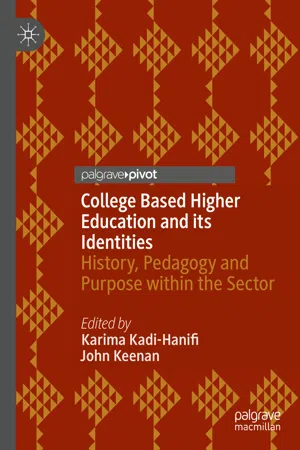What Is College Based Higher Education?
Just over 10% (ETF 2016) of higher education students study for their diplomas and degrees through CBHE, including private providers, making it a highly significant feature of the current English higher education landscape. CBHE has developed in many forms, most notably through partnerships with higher education institutions (Elliott and Gamble 2001). These range from franchise arrangements in which the university validates the course, resources and staffing, leaving the college to undertake all of the teaching, to fully collaborative provision under which teaching is shared between the university and the college and may take place in either or both institutions. Many colleges have developed higher education courses themselves, most commonly offering Higher National Diplomas and Certificates (HNDs and HNCs) awarded by Edexcel/BTEC (Business and Technology Education Council). Since 2001, Foundation degrees (FDs), often developed with local employers, have become popular. FDs, that are specifically linked to local skills and employment needs, have formed an important part of the efforts of colleges to widen participation, often appealing to non-traditional students including those from social groups under-represented in HE, mature students, women and those without formal qualifications (Lillis 2001; QAA 2015; Mason 2018). The award was introduced in England specifically to meet the needs of students wishing to combine academic and vocational higher education courses, with the curriculum often tailored to a single profession or occupational area. It is equivalent to two-thirds of an Honours degree and is often studied part-time to enable students to combine earning and learning. So what explains CBHE?
Colleges have for many years been sites of educational imagination and innovation (NIACE 2009), committed to providing both liberal and vocational educational opportunities (Hodgson and Spours 2015), principally for the communities in which they are located and reflecting, like those communities, a diverse heterogeneity (Ainley and Bailey 1997; BIS 2012). For many colleges, particularly those in larger metropolitan areas, this mission included developing a broad higher education portfolio, often specifically designed to provide vertical progression from their own BTEC National and A level courses (see Eaton 2015). A strong access and outreach mission underpinned these arrangements. For many further education (FE) students, participating in a university higher education experience is highly problematic—inability or unwillingness to travel, diverse social and cultural capital, family and parenting ties, the need to work full-time or part-time (Bathmaker 2016), amongst the barriers to their engagement. On the other hand, colleges have routinely developed locally accessible higher education, with flexible attendance requirements to fit around childcare arrangements, learning opportunities and environments adapted to suit student needs, characteristics and capabilities (Elliott 1999), and a generally supportive and highly committed workforce, ‘more likely to be around for most of the day and ready to offer that support, in contrast to a typical HE environment, where an academic (often for good reason) may not be so readily available’ (Lea and Simmons 2012: 187).
We will see in the next section how the formation and development of FE Colleges in the last century laid the ground for CBHE. This history is important because it helps to explain the complex reality of the contemporary FE sector. As Coffield et al. (2008: 163) have persuasively argued, FE lies in the space between two contradictory narratives. On the one hand, there is the government rhetoric of ‘rising investment, increasing participation and substantial achievements’; on the other hand there is the practitioner reality of ‘frustration, of constant struggles to keep services going and of increasing concern for the future of the sector’. At the heart of this tension, and fuelling it, is the increasing ‘symbiosis of performativity (that) has evolved from government reforms, which indicates how the gap between national initiatives and local practice is perpetuated’ (Orr 2009: 480).
It wasn’t until the election of the Labour Government in 1997 that FE became a prominent part of government policy for education (Lucas 2004). As Rapley (2012) notes, ‘Since Dearing and the advent of Foundation degrees, HE in FE has developed from a peripheral sub-group of HE to one with a strategic and widely recognised function and purpose’. In fact, FE became the focus of two binary government policies: social justice through widening participation in education; and enhancing national economic competitiveness through improving workforce skills (Orr 2008). This illustrates a fundamental tension that has shaped the sector and it is one that is significant in informing our understanding of the character and future opportunity of CBHE.
Just as the early colleges met a range of educational needs, that tradition continues today; furthermore, there has never been such a golden opportunity for colleges to extend their higher education portfolio. We have seen over the last couple of decades an incremental dismantling by government of the infrastructure for higher education, reflecting wider free market ideology driven reforms throughout education and the wider public sector. The notion of what a university is has changed, with smaller and private institutions now eligible to apply for university status. Colleges, for the first time, have been eligible to award their own degrees under clearly defined regulations issued by the Department for Business, Innovation and Skills (2010). The raising of higher education student tuition fees to a maximum of £9000 in 2012 (at the time of writing increased with inflation to £9250) provided an immediate opportunity for FE colleges to compete for HE students on price. Without many of the buildings and other resource infrastructure and staffing costs of much larger universities, many colleges could charge half as much or...
